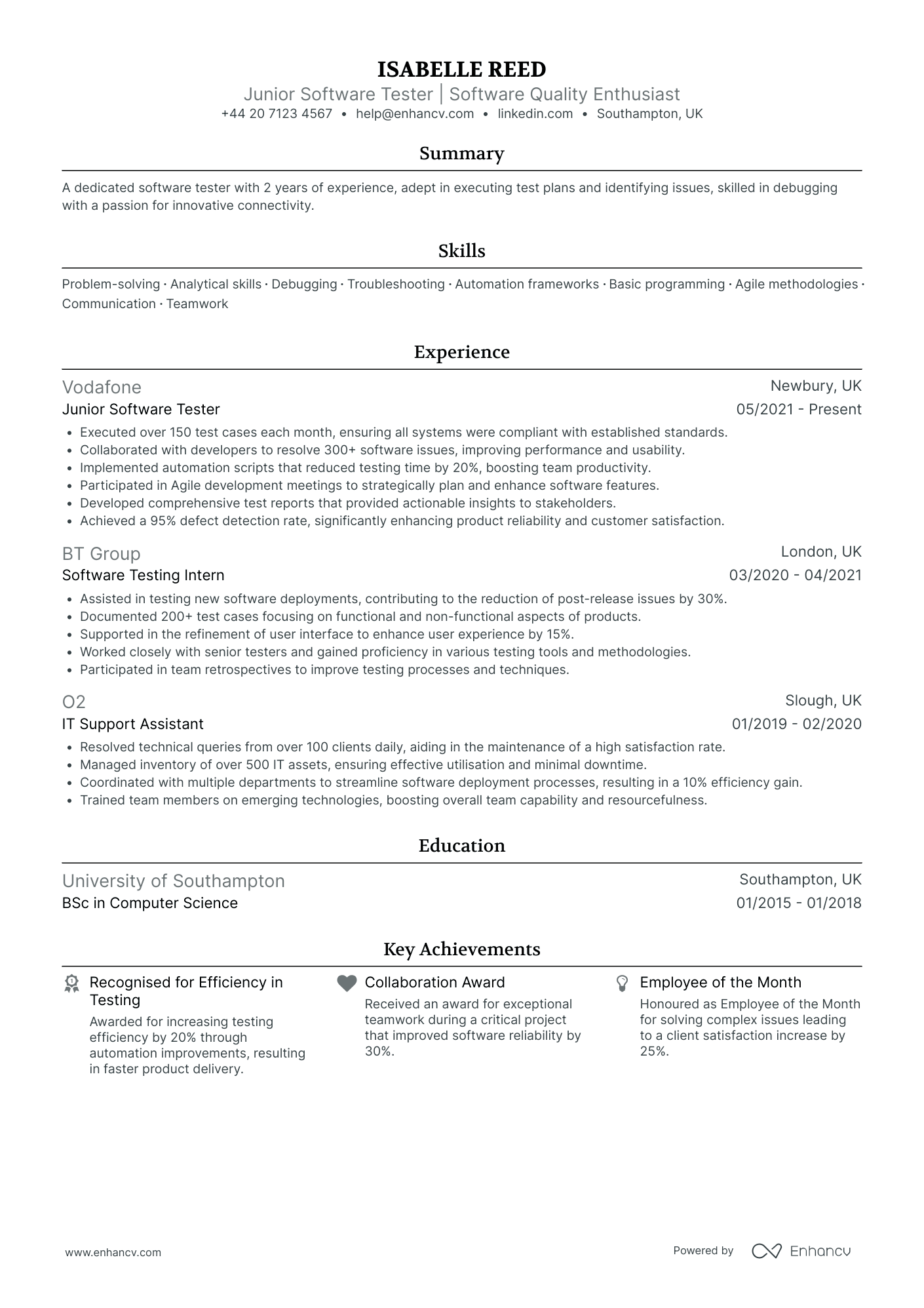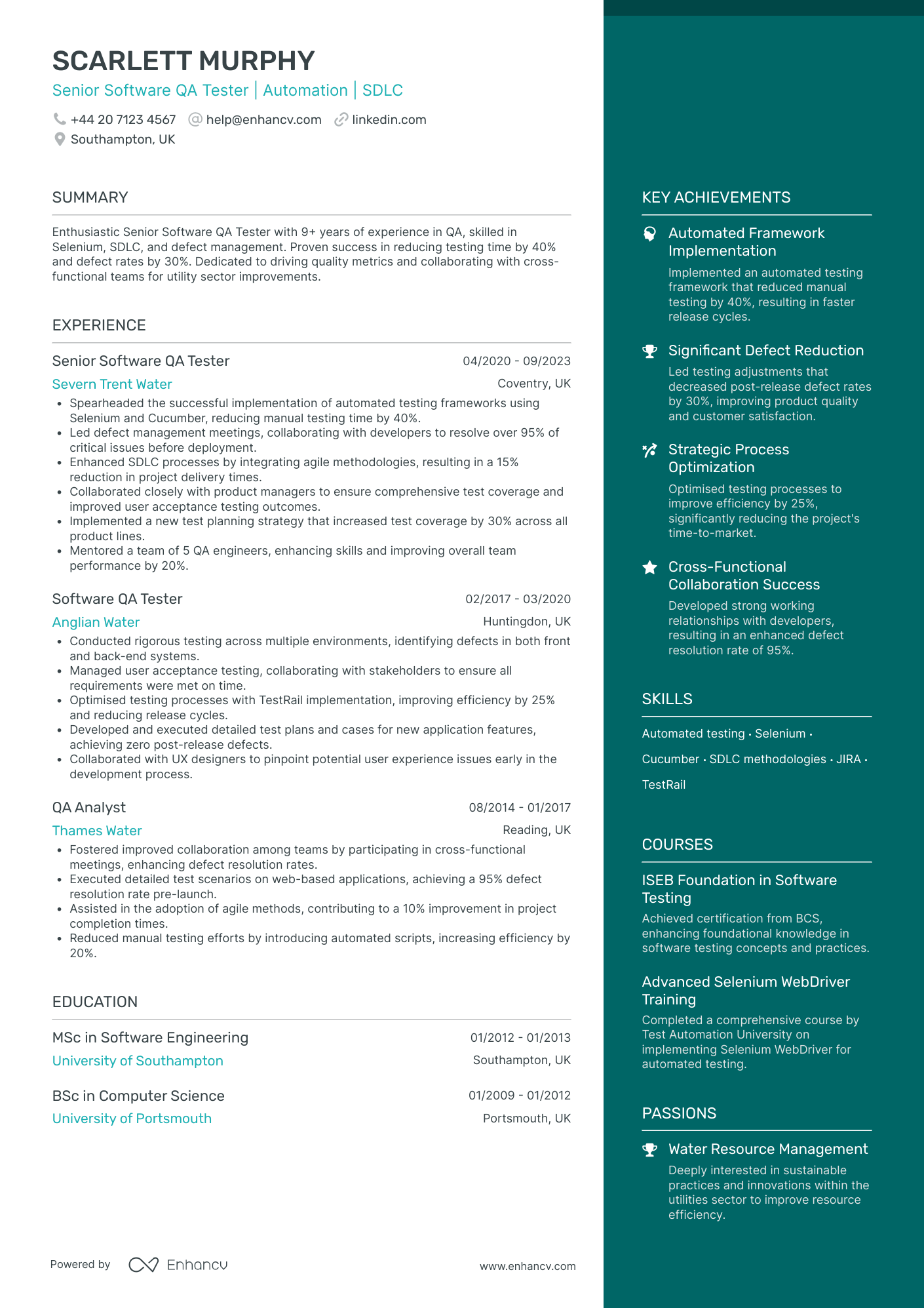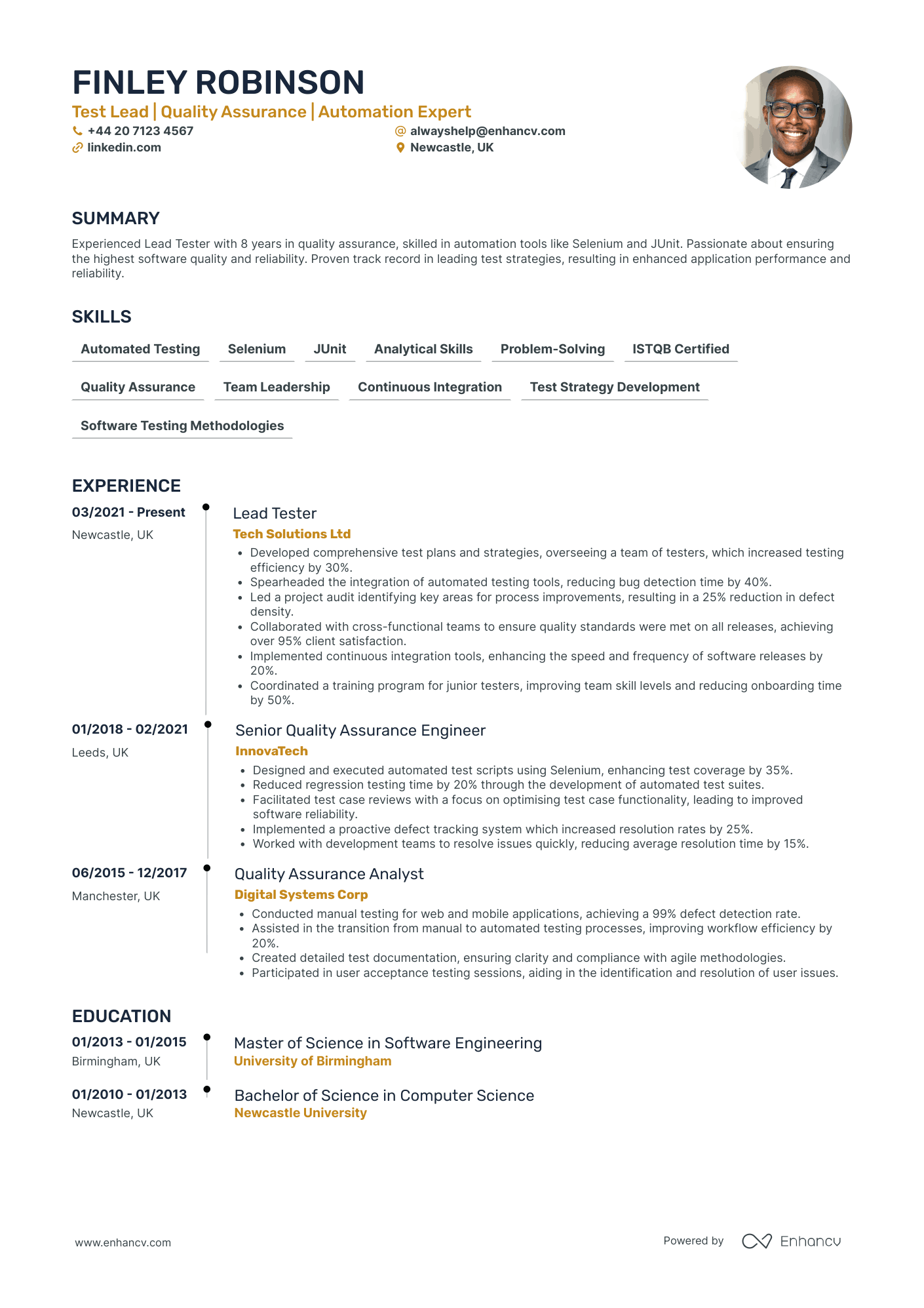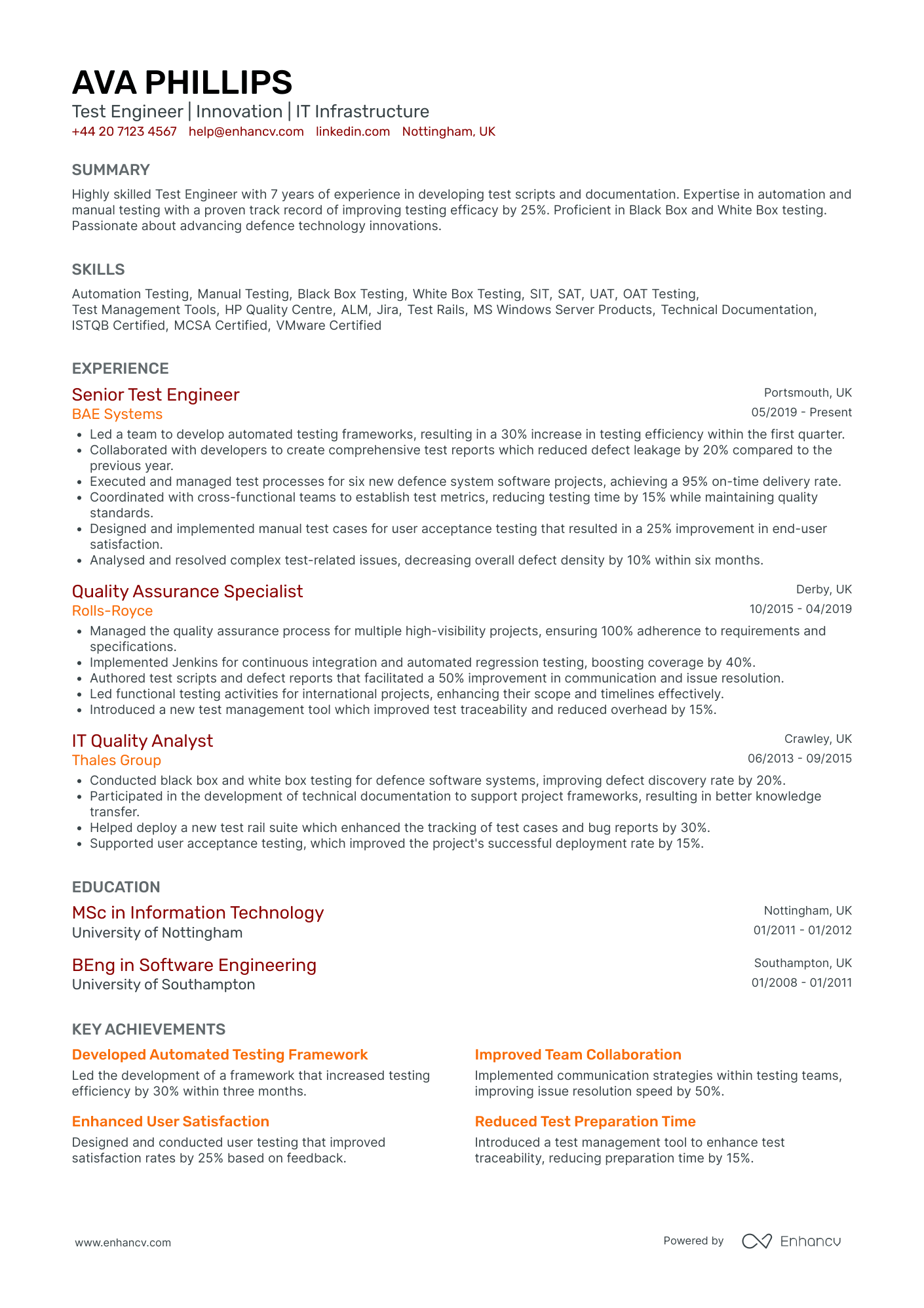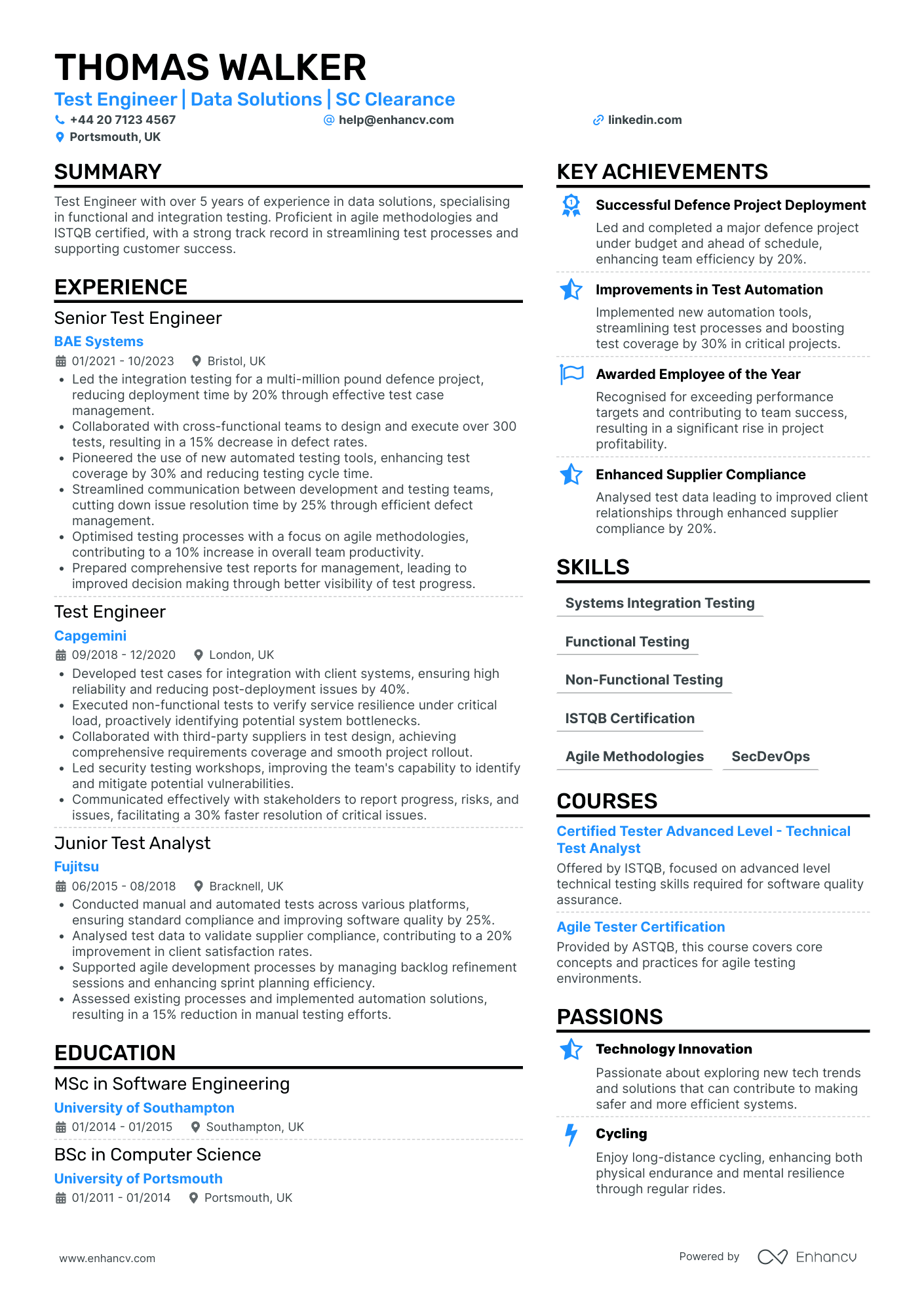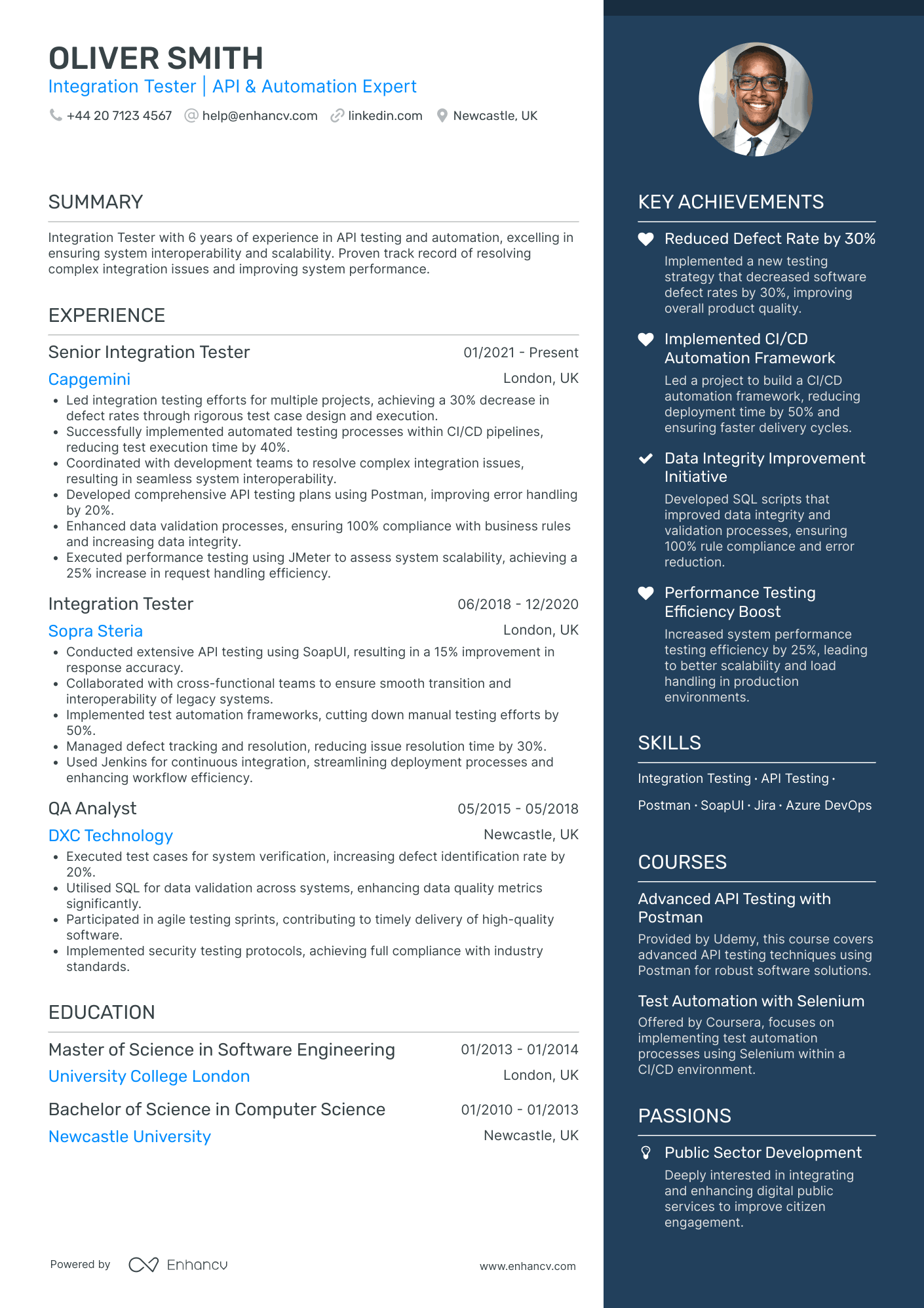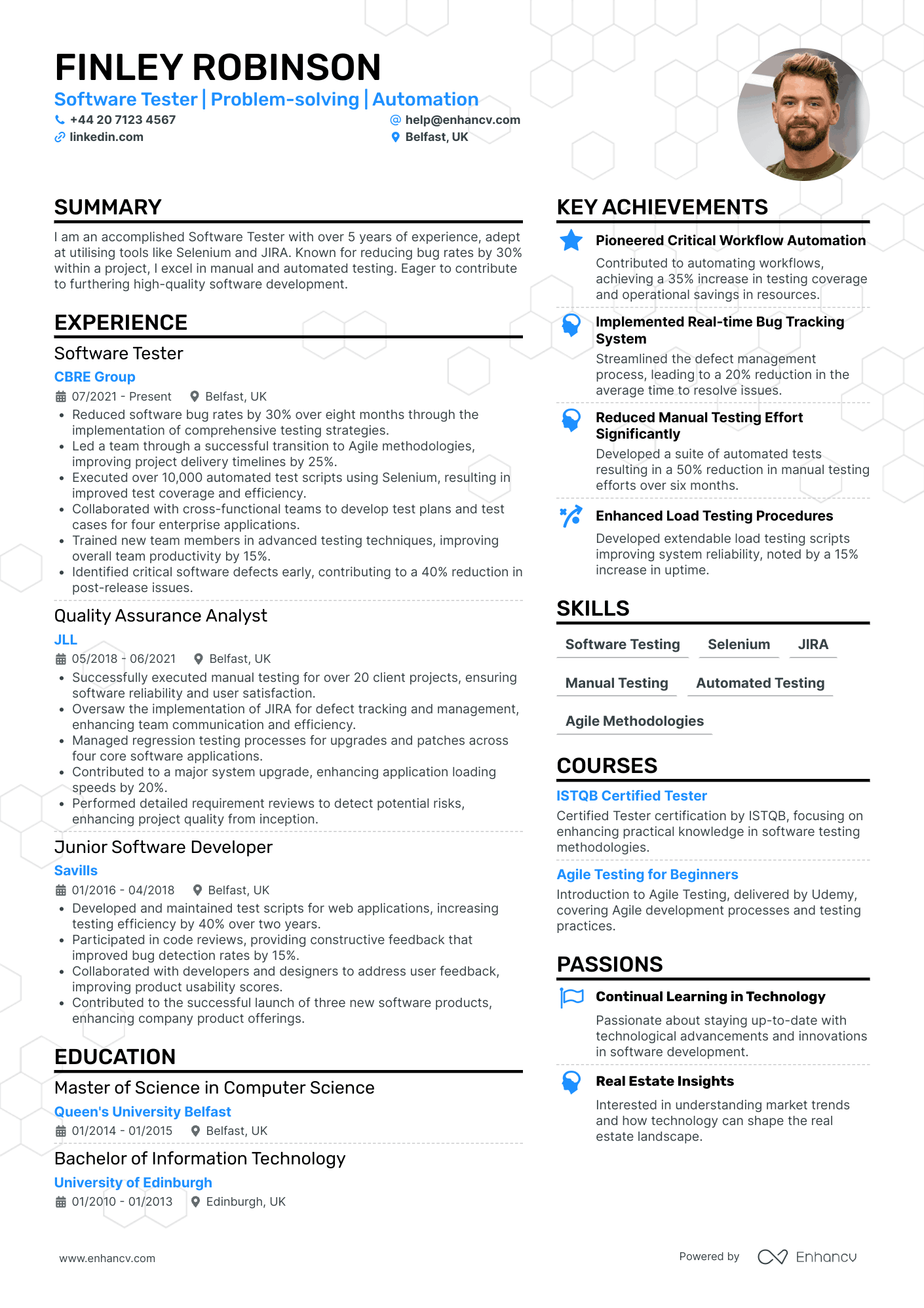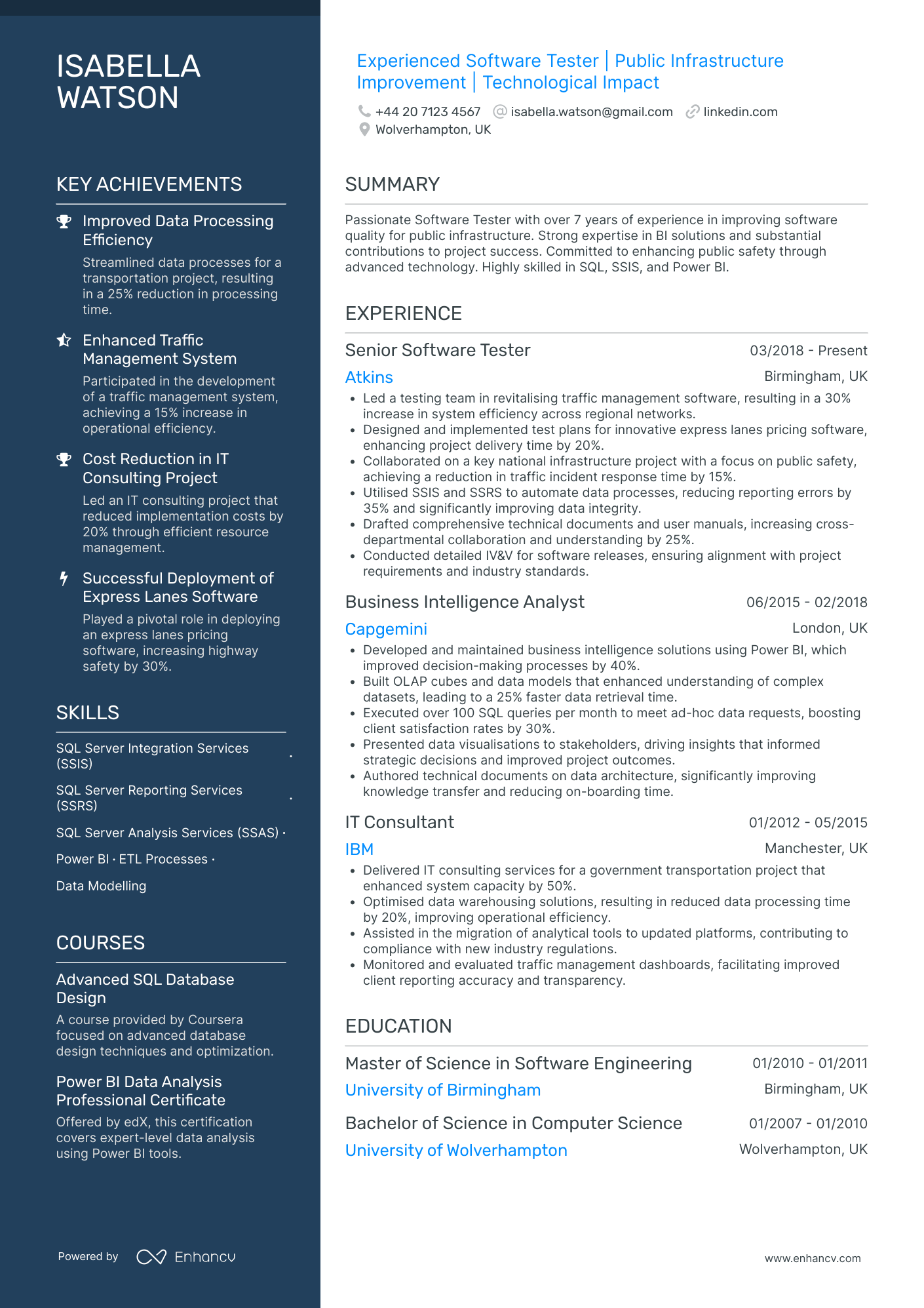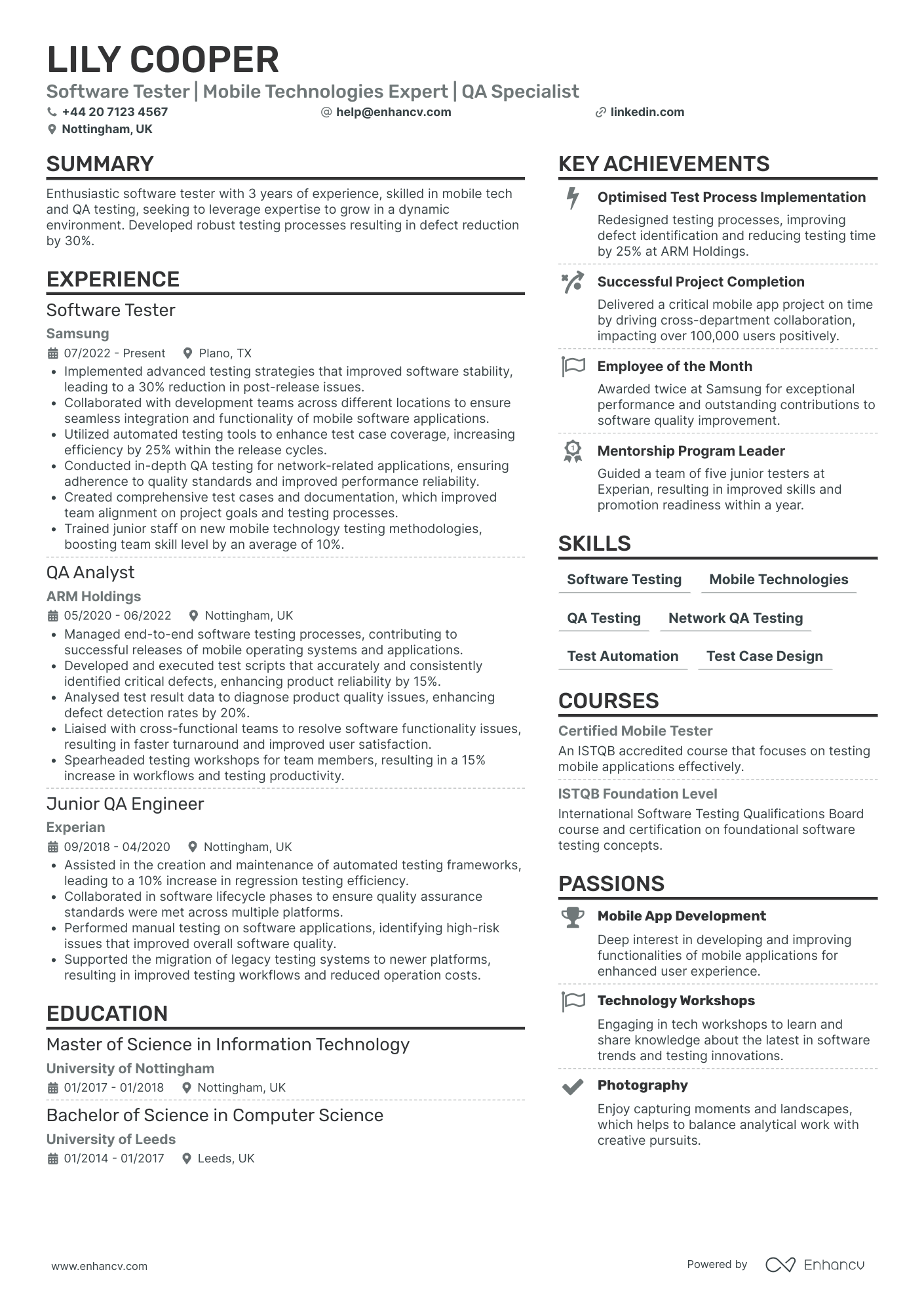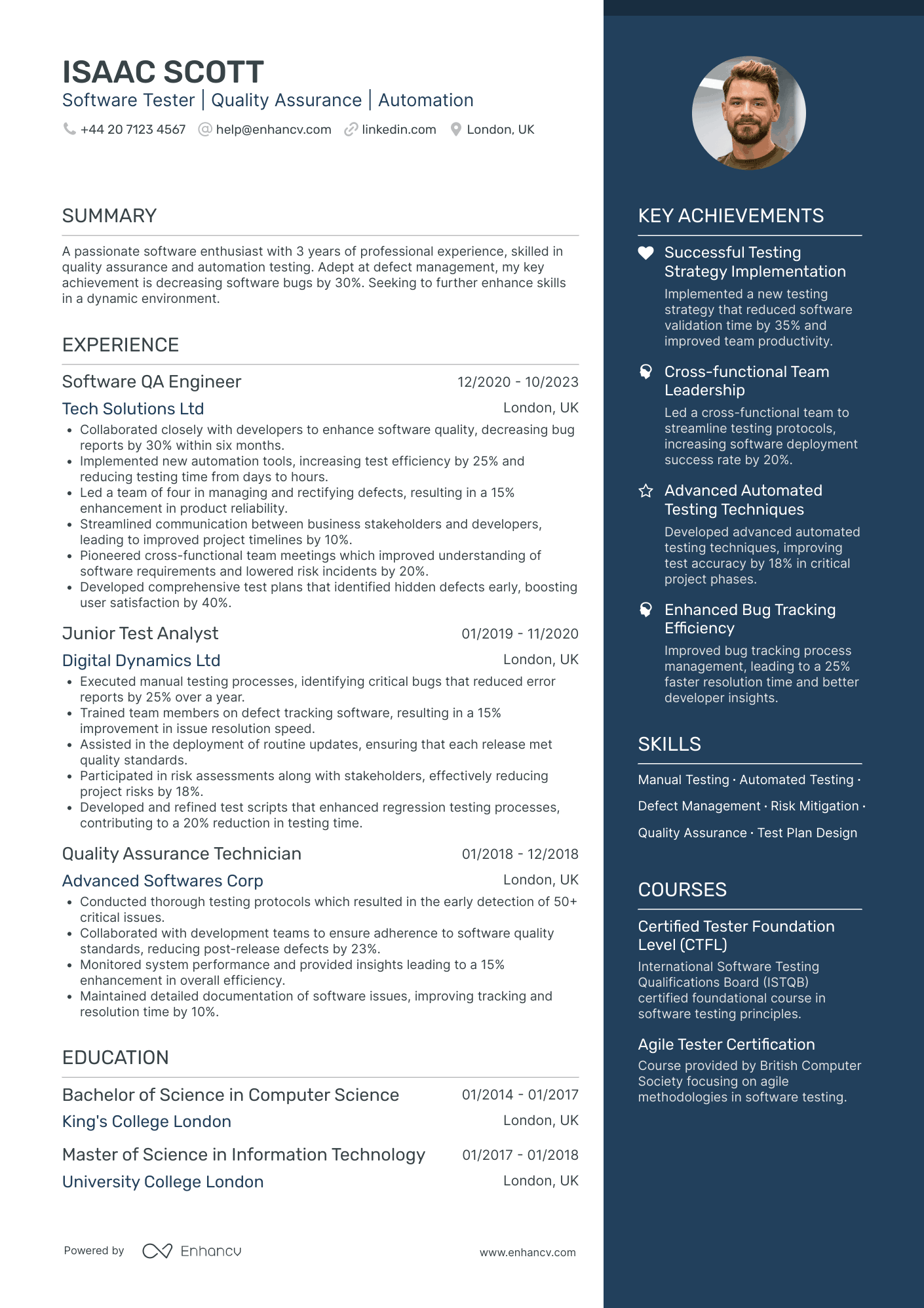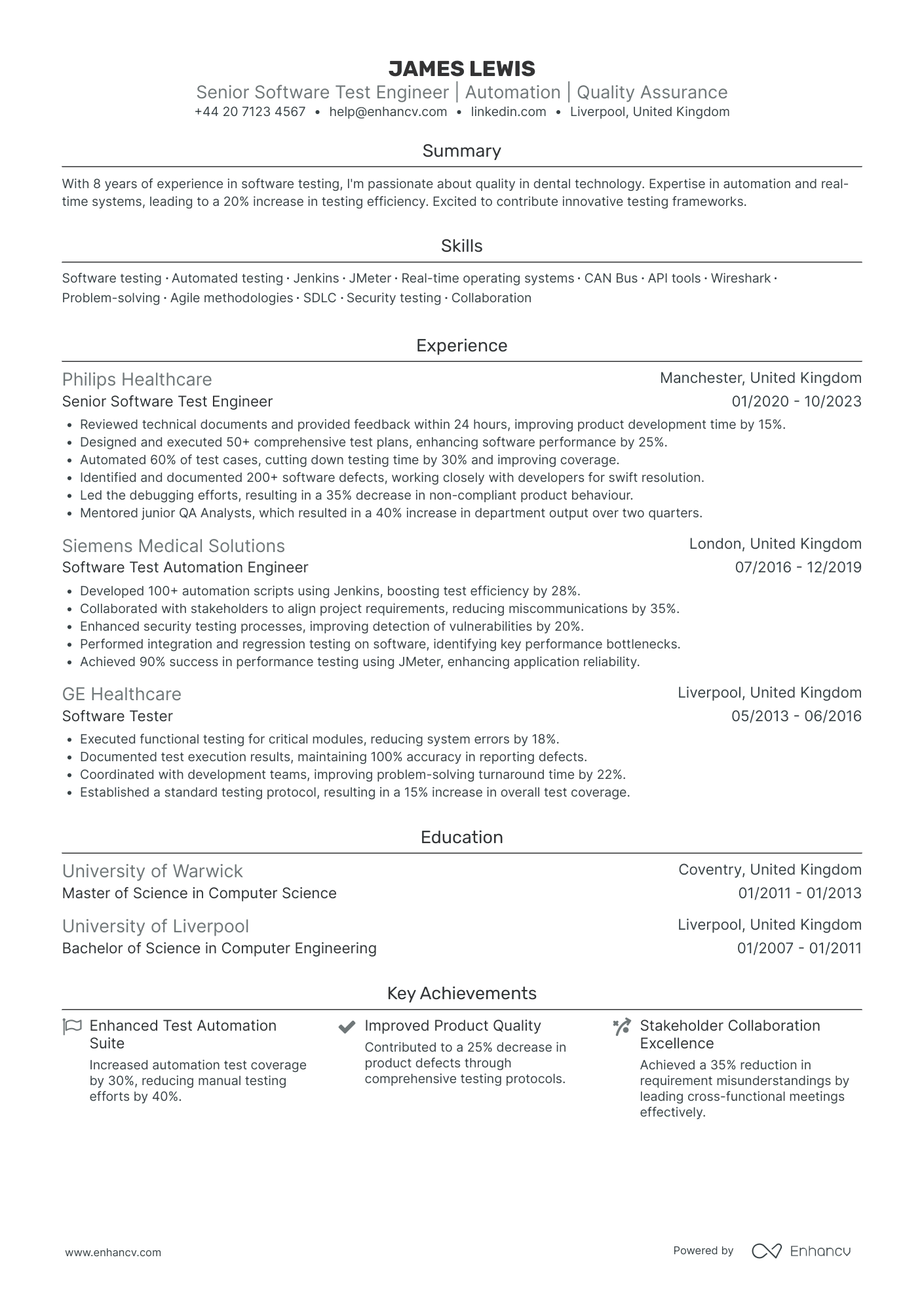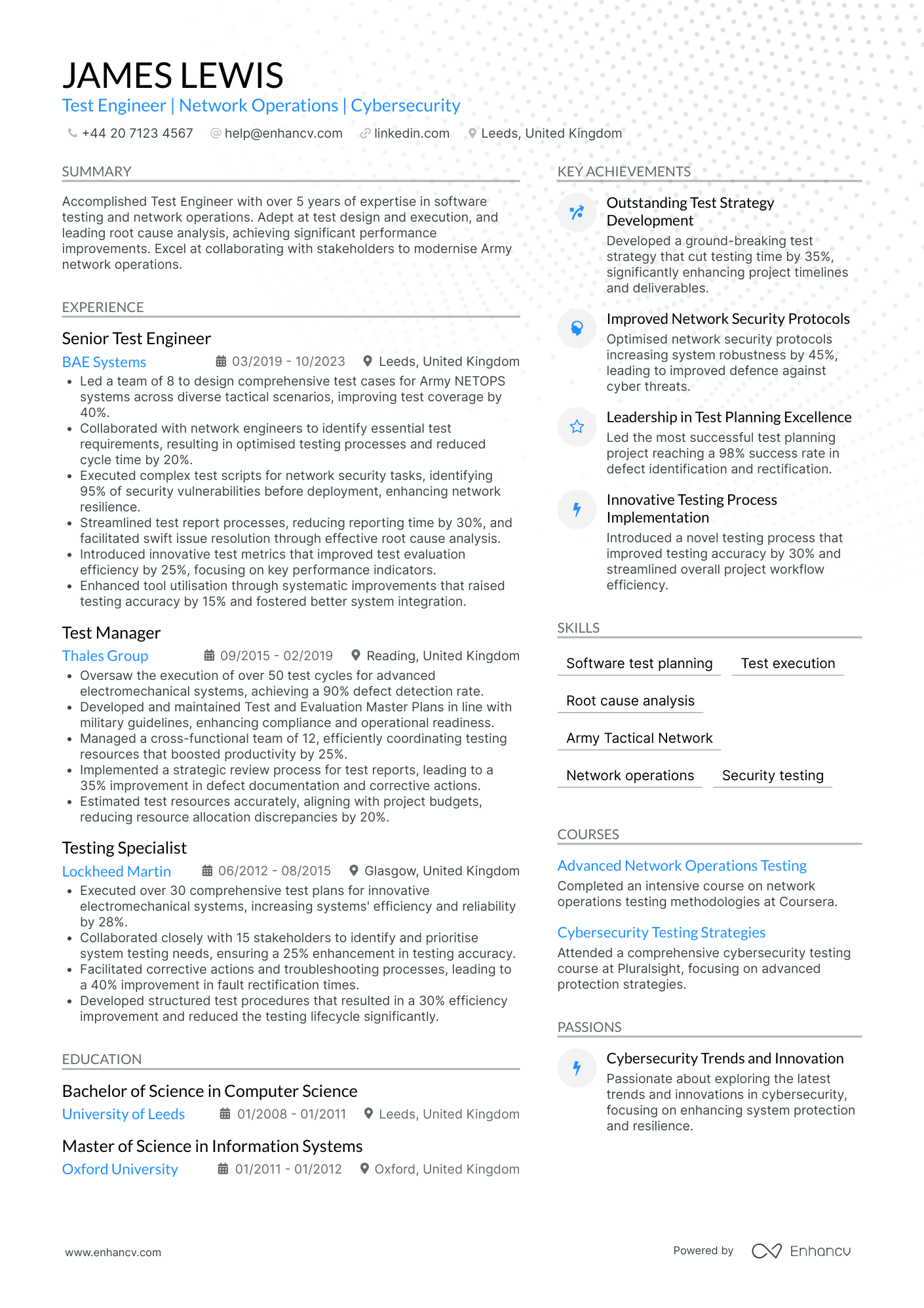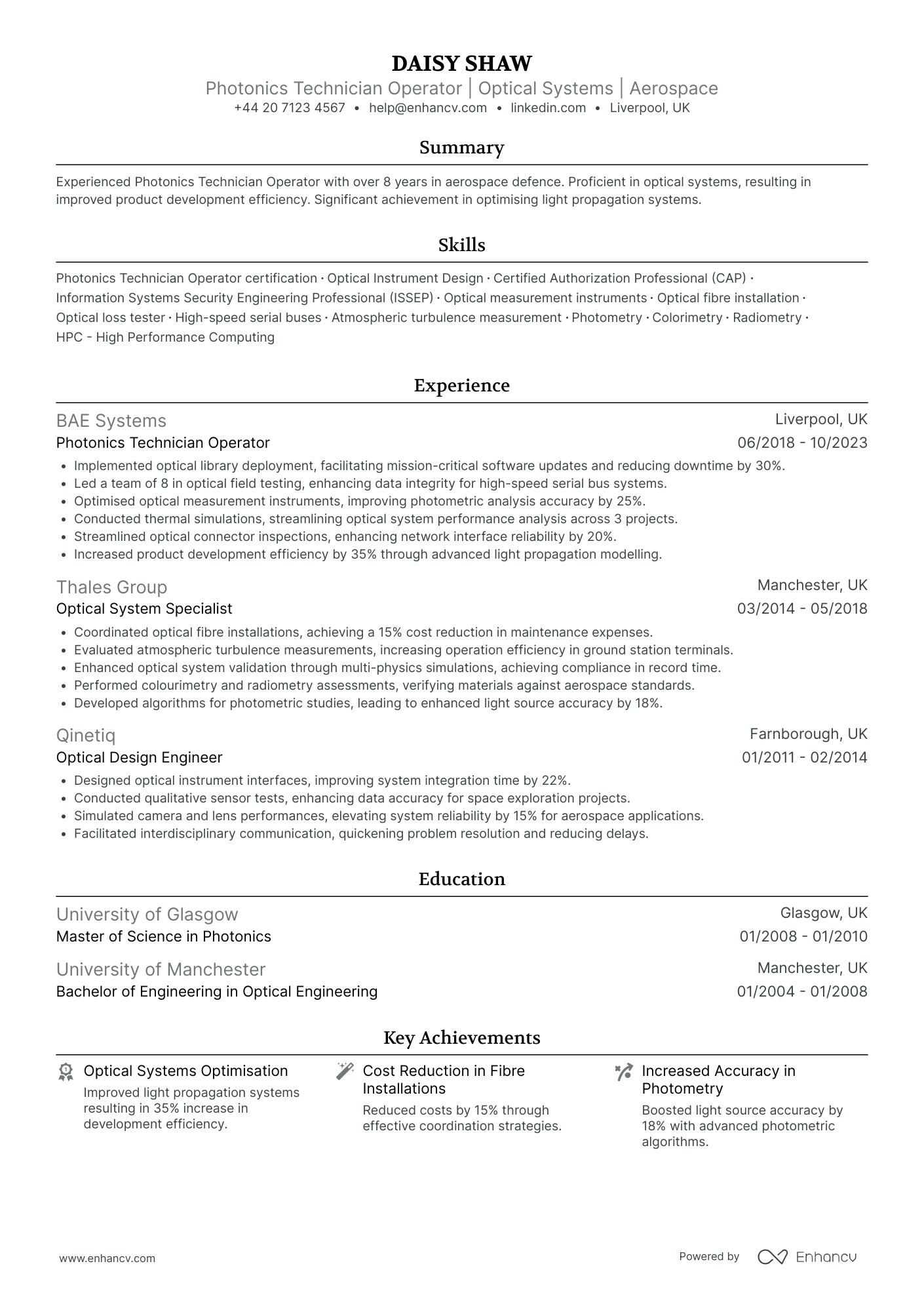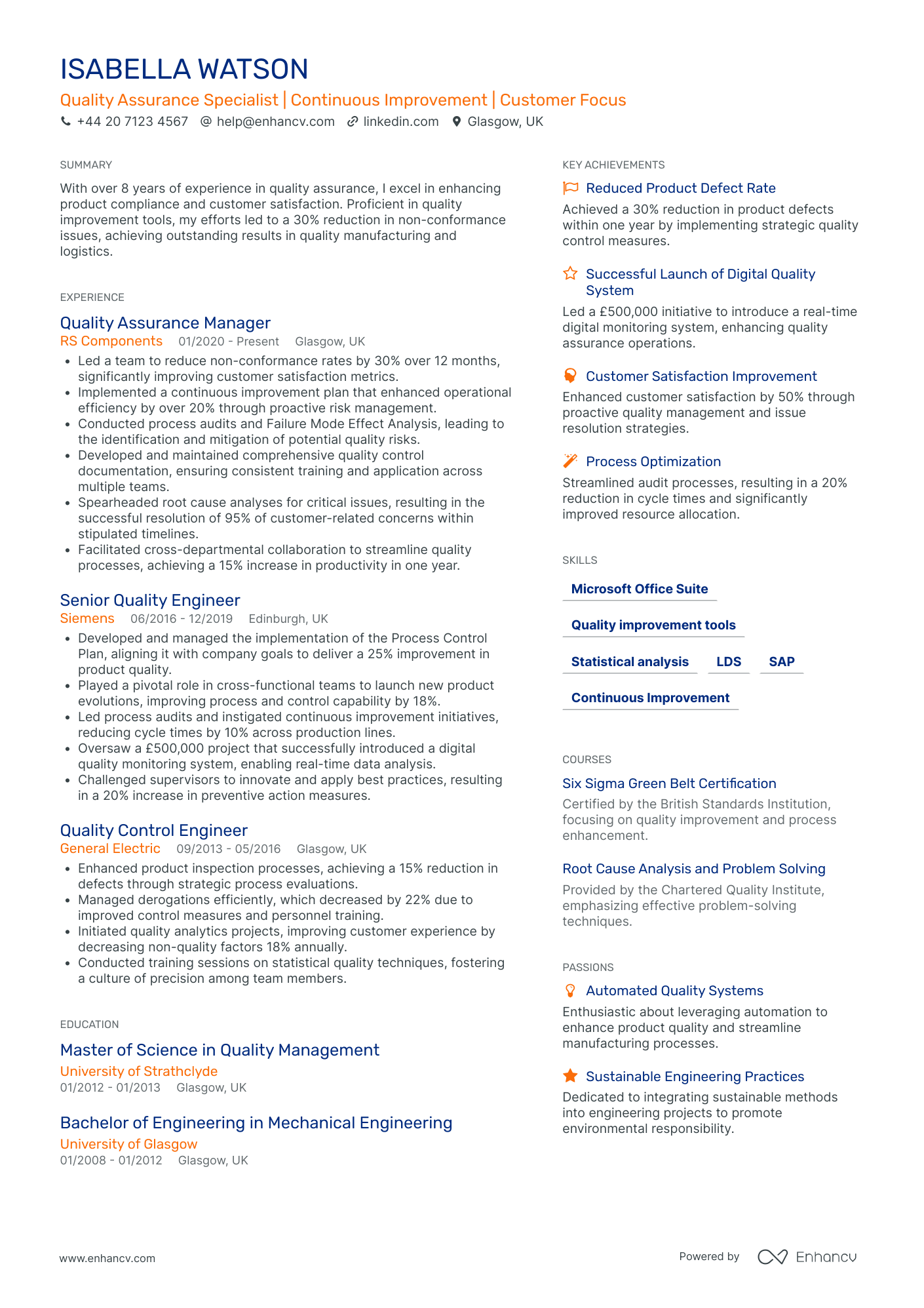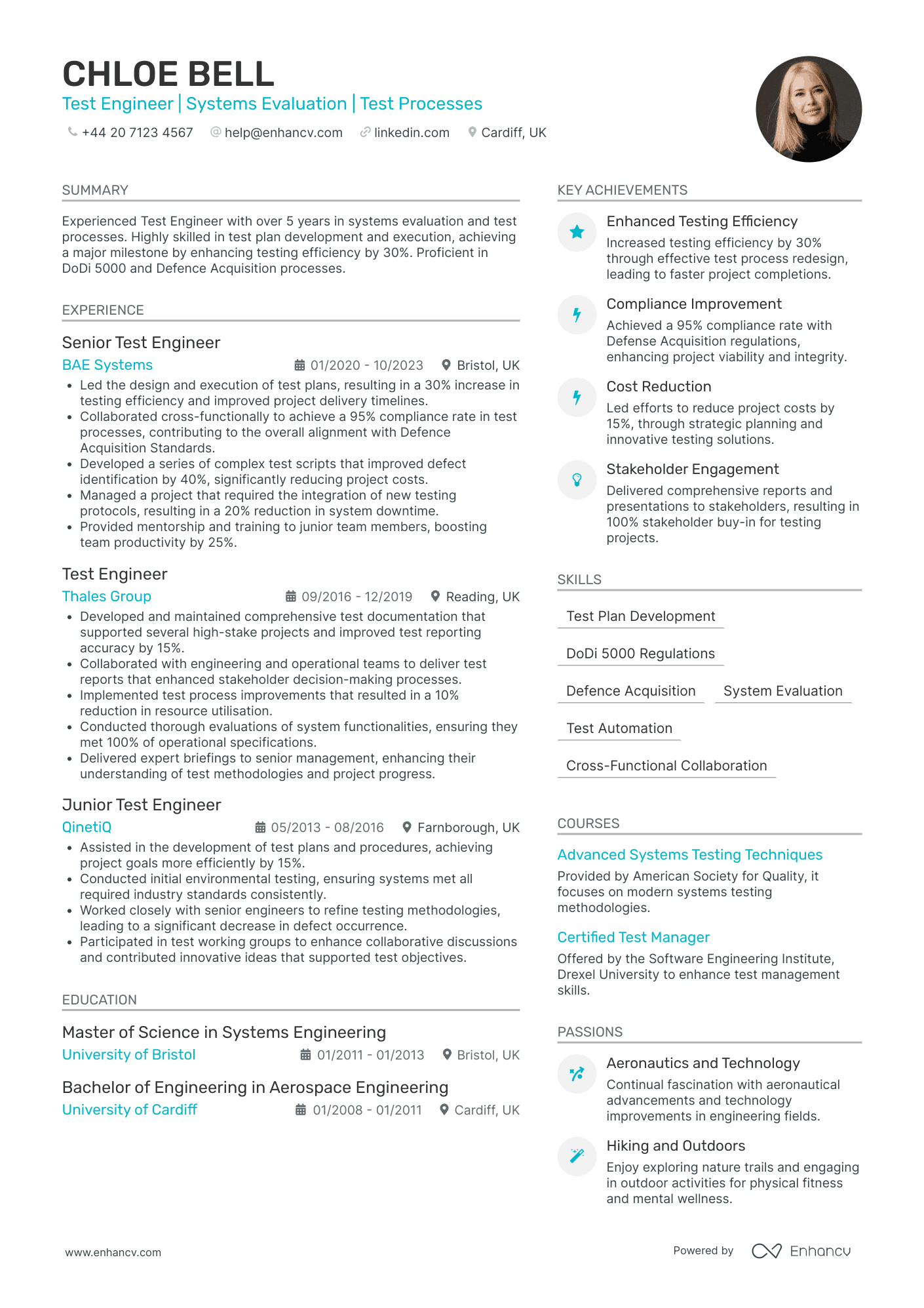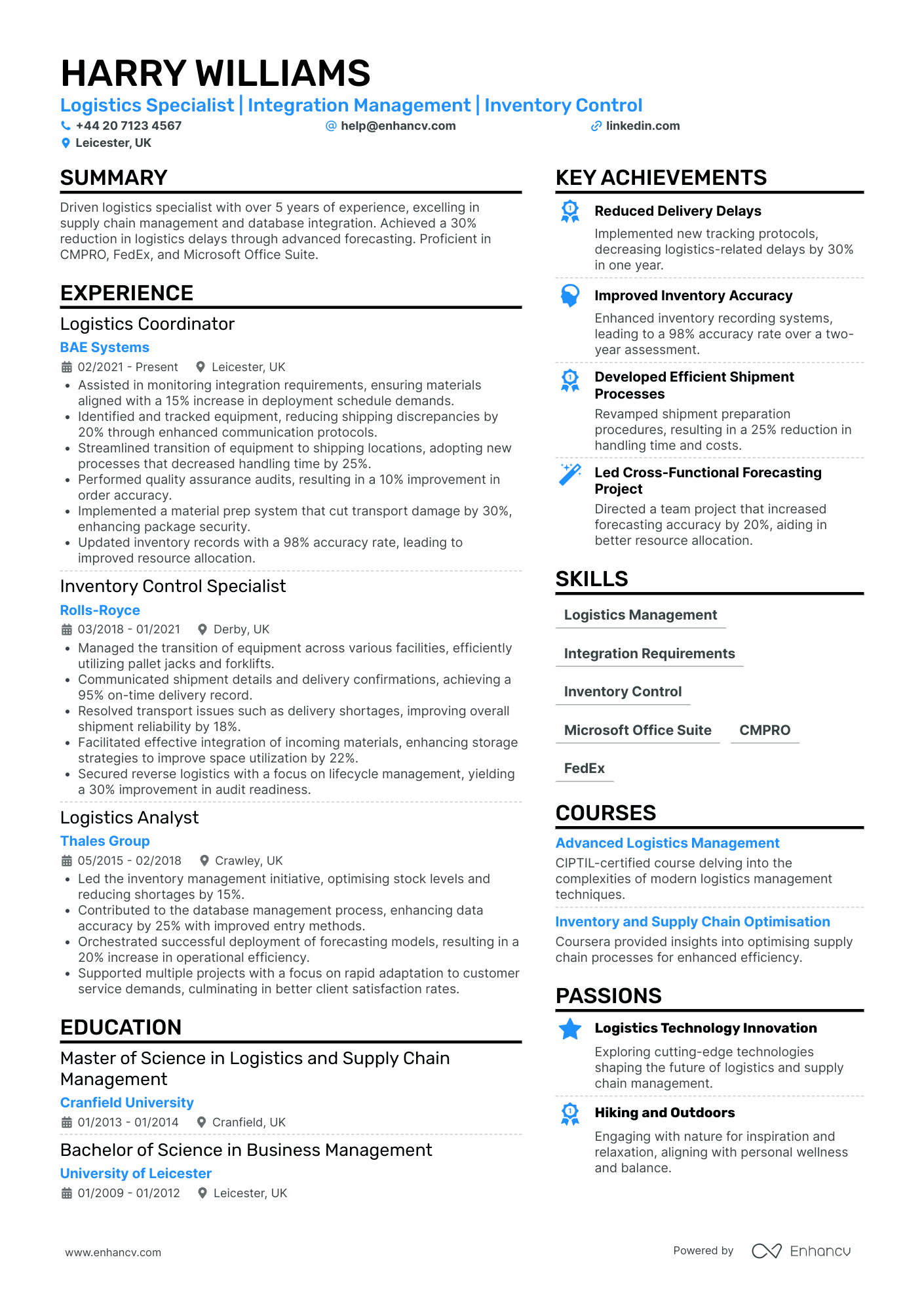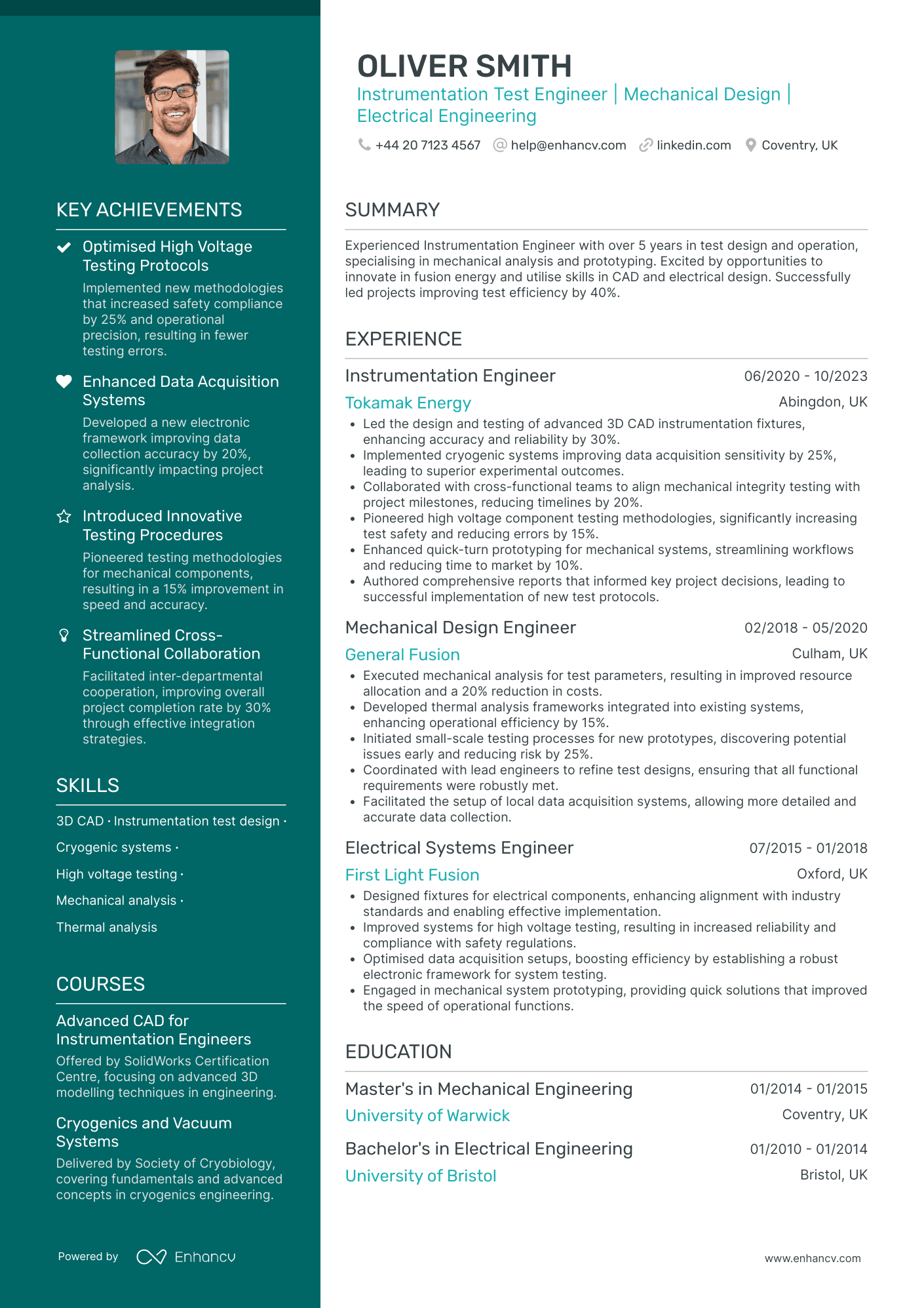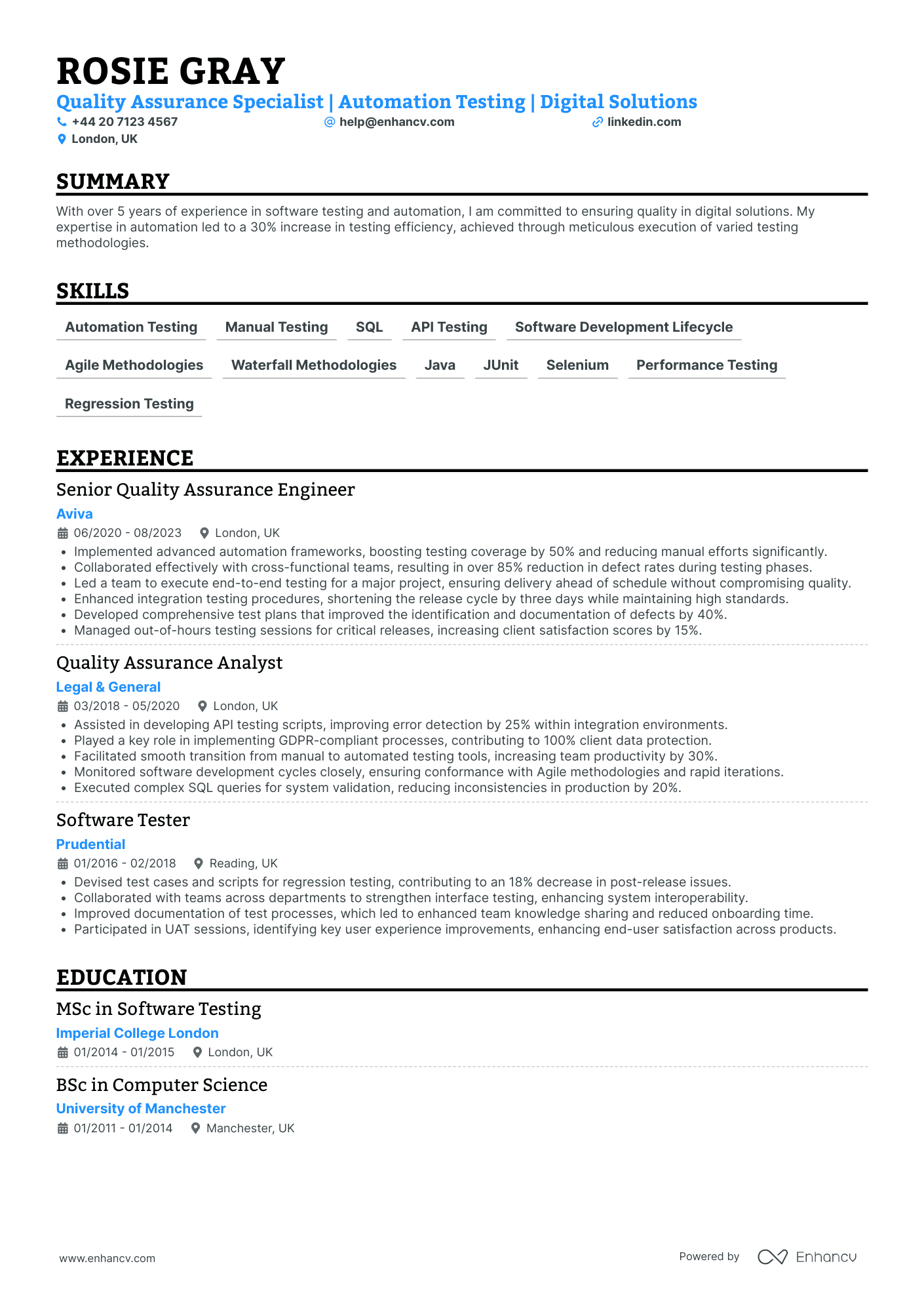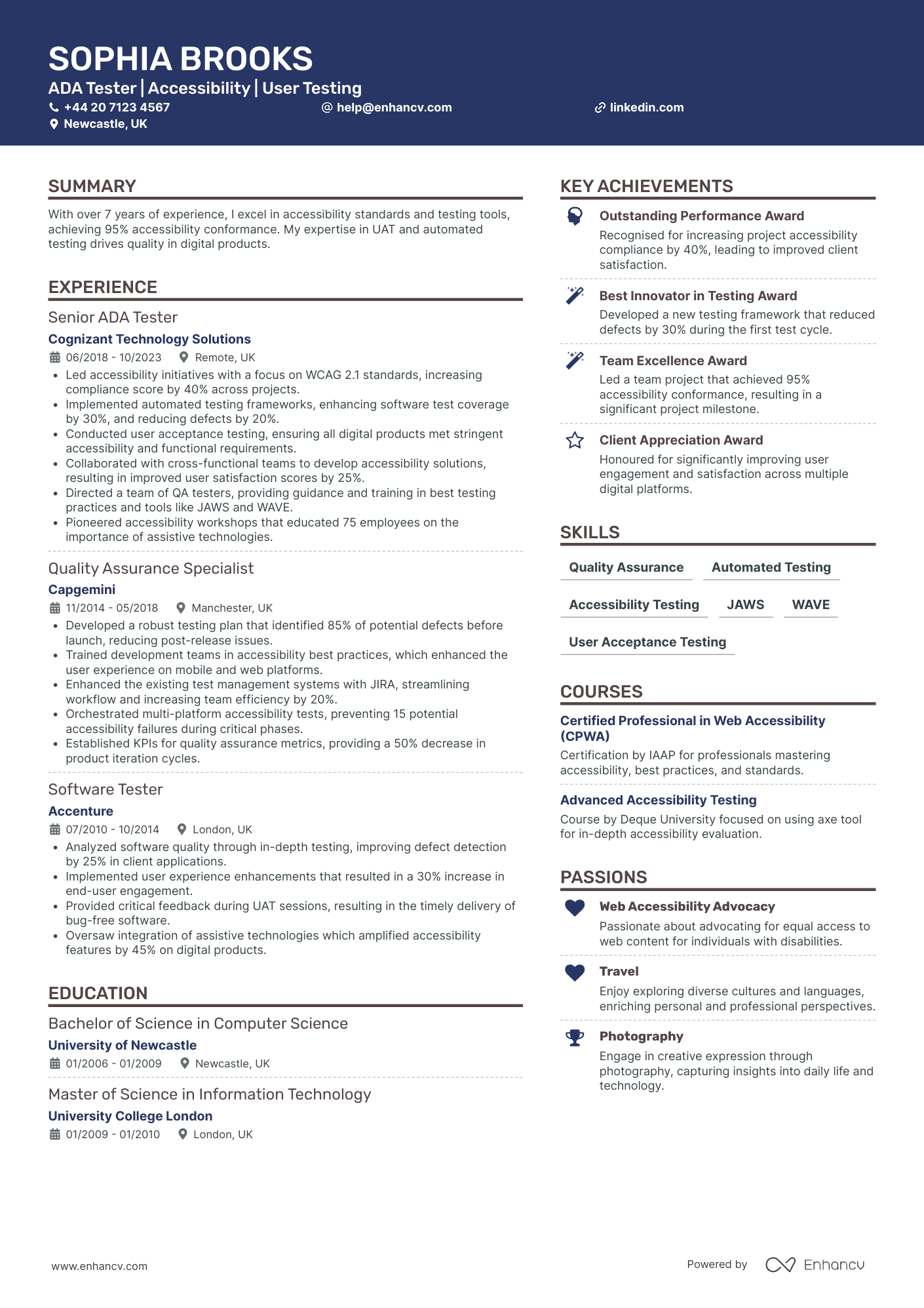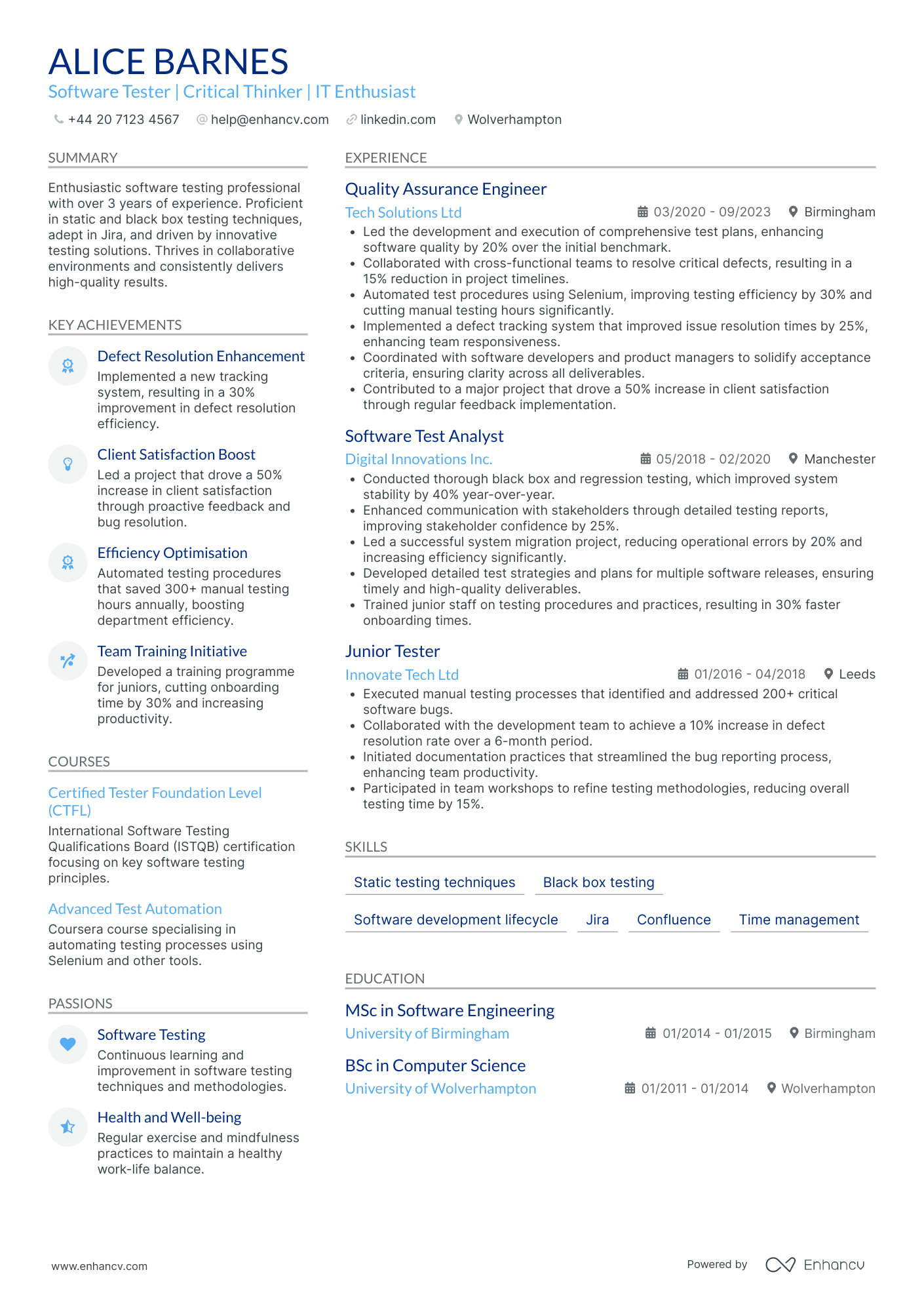Crafting a CV that stands out can be particularly challenging for software testers due to the necessity of showcasing both technical expertise and attention to detail. Our guide is designed to help you highlight your unique skills and experience, ensuring your CV is both impressive and reflective of your professional capabilities.
- Applying the simplest CV design, so that recruiters can easily understand your expertise, skills, and professional background;
- Ensuring you stand out with your header, summary or objective statement, and a designated skills section;
- Creating your CV experience section - no matter how much expertise you have;
- Using real life professional CV examples to enhance the structure and outline of your profile.
If you still have no muse to write your professional CV, find some more industry-leading examples.
CV examples for software tester
By Experience
Junior Software Tester
- Content Presentation: Structured Clarity - The CV is structured with clarity, organizing information under distinct sections with concise bullet points that efficiently convey key responsibilities and accomplishments, making it easy for readers to understand Isabelle Reed's expertise and experience in software testing.
- Career Trajectory: Steady Progression - Isabelle Reed's career trajectory showcases a consistent growth path within the telecommunications industry, from an IT Support Assistant to a Junior Software Tester at a prestigious company like Vodafone, indicating her commitment to advancing in the field of software quality assurance.
- Industry-Specific Elements: Technical Proficiency - The CV highlights Isabelle's technical proficiency by detailing her familiarity with various tools and methodologies, such as automation frameworks and Agile methodologies, crucial for a career in software testing and indicative of her technical depth in the industry.
Senior Software Tester
- Structured Content Presentation - The CV is meticulously organized, with clear, concise sections that effectively present key information at a glance. Each section is purposefully laid out to guide the reader through Scarlett Murphy's qualifications, ensuring that her skills, experience, and achievements are easy to digest and comprehend. This clarity in presentation underscores her competence and professionalism.
- Noteworthy Career Progression - Scarlett Murphy’s career trajectory demonstrates significant growth, moving from a QA Analyst to a Senior Software QA Tester. Her progression through well-respected companies in the utilities sector, such as Severn Trent Water and Anglian Water, reflects her increasing responsibilities and the trust in her technical and leadership abilities. This progressive journey indicates resilience and ambition in her professional path.
- Impactful Achievements and Business Relevance - The CV highlights Scarlett's accomplishments with precision, demonstrating not just numbers but real business impact. Implementations like the automated testing framework that reduced manual testing time by 40% show how her contributions lead to tangible improvements in efficiency and project delivery. These achievements reflect her ability to drive organizational success through strategic enhancements in quality assurance processes.
Lead Software Tester
- Clarity and Structure in Content Presentation - Finley Robinson's CV is impressively structured, enabling easy navigation through the document. Sections are clearly delineated with precise headings, such as Experience, Education, Skills, and Achievements, ensuring that the reader can quickly locate pertinent information. The concise bullet points further enhance clarity, allowing the reader to grasp significant accomplishments and responsibilities at a glance, which underscores Finley's efficiency and attention to detail.
- Career Growth and Leadership Development - The career trajectory outlined in the CV illustrates a clear path of professional growth, marked by progressively senior roles from Quality Assurance Analyst to Lead Tester. This progression not only highlights Finley's advancement in the field but also showcases burgeoning leadership skills, as seen in his responsibilities such as overseeing testing teams and spearheading strategic process improvements. The consistent upward movement within various companies underscores adaptability and competence.
- Impactful Achievements and Business Relevance - The CV makes a strong impact by including quantifiable achievements that are directly tied to business outcomes. For instance, integrating automated testing tools led to a 40% reduction in bug detection time, and developing test plans resulted in a 25% reduction in defect density. These figures reflect not just technical expertise but also a deep understanding of how testing improvements can enhance software reliability, customer satisfaction, and business efficiency.
By Role
Automation Software Tester
- Strategically Structured Experience - Ava Phillips' CV is well-organized, presenting her career journey from IT Quality Analyst to Senior Test Engineer clearly and logically. Each role is detailed with specific achievements, reflecting a structured career progression that paints a picture of continuous growth and enhancement in her field.
- Distinct Technical Proficiencies - The CV stands out by highlighting Ava’s proficiency in a wide array of industry-specific tools and methodologies. Her expertise in automation and manual testing, along with her certifications in ISTQB and Microsoft Azure DevOps, underline her advanced technical skill set. This depth of technical ability is essential for her role and unquestionably beneficial in tackling complex engineering challenges.
- Broad Impact Through Achievements - Ava’s accomplishments, such as improving testing efficiency by 30% and reducing defect leakage by 20%, showcase not just technical prowess but also her focus on delivering significant business value. Her ability to enhance user satisfaction by 25% and improving collaboration speeds by 50% further cement her effectiveness in driving positive change within her teams and organizations.
Manual Software Tester
- Effective Use of Quantifiable Achievements - Thomas Walker's CV is noteworthy for its detailed listing of measurable successes in each position held. For example, reductions in deployment time by 20% and defect rates by 15% provide concrete evidence of his contributions to organizational efficiency and quality improvements.
- Clear Career Advancement - The progression from a Junior Test Analyst to a Senior Test Engineer demonstrates consistent professional growth and increased responsibility. This trajectory showcases his strong performance and ability to adapt to more complex roles over time, highlighting significant career development within notable organizations.
- Comprehensive Industry-Specific Competencies - The CV thoroughly details Thomas's proficiency with pivotal testing methodologies and tools, such as integrating automated testing solutions and focusing on agile methodologies. His technical depth is underscored by ISTQB certification and his success in streamlining processes, solidifying his expertise in software testing within defense and data solutions sectors.
Performance Software Tester
- Clear and Structured Content Presentation - The CV is meticulously organized, allowing easy navigation through different sections like experience, education, skills, and achievements. Bullet points in each job role ensure concise communication of responsibilities and accomplishments, while headers make it easy to find specific information quickly.
- Continuous Professional Growth - Oliver's career trajectory demonstrates significant growth, progressing from a QA Analyst to a Senior Integration Tester within a five-year span. This progression highlights his ability to take on increased responsibilities and succeed in more complex project environments, reflecting his commitment to professional development.
- Proficiency in Industry-Specific Tools and Methodologies - This CV distinctly showcases Oliver's expertise with key industry tools like Postman, SoapUI, and JMeter, as well as methodologies such as microservices architecture and CI/CD processes, suggesting a strong technical depth that makes him an ideal candidate for advanced integration testing roles.
By Industry
Software Tester in Telecommunications
- Exemplifies a Solid Career Trajectory - Finley Robinson's CV outlines a logical career progression from a Junior Software Developer to a Software Tester at CBRE Group. Each role demonstrates increased responsibility and focus on quality assurance, showcasing growth through diverse experiences in software testing, from manual to automated processes.
- Comprehensive Use of Industry-Specific Tools and Methods - The candidate's proficiency in industry-standard tools, such as Selenium and JIRA, is underscored throughout the CV. Their expertise in Agile methodologies and thorough understanding of both manual and automated testing underscore their deep technical competence and relevance in the field.
- Diverse Achievements with Significant Business Impact - Finley's achievements are not just quantified but clearly aligned with business outcomes. For example, reducing bug rates by 30% and achieving operational savings through workflow automation denote substantial contributions to process efficiency and product quality, emphasizing the candidate’s ability to impact overall organizational performance positively.
Software Tester in Financial Services
- Concise and Well-Structured Presentation - The CV is presented in a clear, logical structure that begins with contact information, followed by an impactful summary, and flows seamlessly into detailed sections for experience, education, skills, and more. This structure facilitates easy navigation and ensures the reader can quickly grasp key qualifications and achievements.
- Impressive Career Growth and Consistency - Isabella Watson’s career trajectory demonstrates significant growth, moving from an IT Consultant at IBM to a Senior Software Tester at Atkins. The consistent focus in quality assurance for software systems in public infrastructure showcases not just upward mobility, but also dedication to a particular niche that enhances her expertise and appeal to potential employers.
- Noteworthy Achievements with Measurable Impact - The CV highlights substantial achievements such as increasing system efficiency by 30% and reducing traffic incident response time by 15%. These quantifiable results are directly tied to business and public safety improvements, providing clear evidence of Isabella's contributions and potential value to future projects.
Software Tester in Healthcare
- Career Growth and Adaptability - Lily Cooper's career trajectory demonstrates a clear pattern of growth and increased responsibility. Starting as a Junior QA Engineer and advancing to a Software Tester role at Samsung, her progression showcases a solid foundation and expertise in software testing within different organizational structures and cultural settings.
- Achievements with Business Impact - The CV highlights significant achievements, such as optimizing test processes to reduce defect identification time by 25%. These accomplishments are not only measurable but also demonstrate substantial business impact, enhancing product reliability and customer satisfaction across various projects.
- Comprehensive Skill Set and Technical Proficiency - Lily's CV effectively showcases a diverse set of skills that are essential for the role of Software Tester. Her proficiency in test automation, test case design, and QA testing is complemented by certifications like Certified Mobile Tester and ISTQB Foundation Level, which validate her technical depth and industry-specific expertise.
Software Tester in Video Game Development
- Structured Layout Enhancing Readability - The CV is meticulously structured with clearly defined sections such as experience, education, skills, achievements, and languages. This organization not only enhances readability but ensures that relevant information is easily accessible, which is crucial for hiring managers reviewing numerous applications.
- Consistent Career Progression - The career trajectory of Isaac Scott illustrates a consistent upward path within the tech industry, transitioning from a Quality Assurance Technician to a Software QA Engineer within five years. This progression highlights both the acquisition of advanced skills and increased responsibilities, underscoring his dedication and growth in the field of software testing.
- Rich Technical Expertise with Automation Focus - The CV sheds light on Isaac's deep involvement with industry-specific methodologies, particularly his proficiency with automation tools and test efficiency enhancements. These competencies indicate a strong technical foundation, crucially aligning with modern demands for software testers who can adeptly navigate both manual and automated testing realms.
Software Tester in E-commerce
- Clear and Structured Content Presentation - The CV is well-organized, with sections clearly defined and information presented concisely. Each entry under experience specifies the position, company, and location, followed by bullet points summarizing key responsibilities and accomplishments. This provides an easy-to-follow and visually appealing format that enhances readability.
- Impressive Career Progression - James Lewis's career trajectory is indicative of steady growth and advancement within the software testing field. Starting as a Software Tester and gradually moving up to a Senior Software Test Engineer, the CV showcases a progression through roles of increasing responsibility and complexity, illustrating his dedication and capability in the industry.
- Technical Depth in Automation and Tools - The CV reveals a deep familiarity with industry-specific tools and methodologies, such as Jenkins, JMeter, and real-time operating systems. This technical expertise is further highlighted by certifications and courses in advanced automation testing, emphasizing James’s commitment to staying at the forefront of technological innovations in software testing.
Software Tester in Cybersecurity
- Clear Structure and Conciseness - The CV is well-organized, with clearly defined sections that make it easy to navigate. The concise formatting ensures that each section delivers information effectively without overwhelming the reader, enhancing clarity and comprehension.
- Impressive Career Growth - The candidate’s career trajectory demonstrates significant growth and responsibility within the field, moving from a Testing Specialist to a Senior Test Engineer. This progression highlights their ability to take on more complex roles and adapt to increasing challenges in network operations and cybersecurity.
- Robust Technical Expertise - The document showcases a deep understanding of industry-specific methodologies such as Army Tactical Network operations, test automation frameworks, and DevSecOps tools. This technical depth underlines the candidate's capability to handle specialized tasks within the cybersecurity domain.
Software Tester in Aerospace
- Structured Career Development - Daisy Shaw's CV illustrates a clear growth trajectory within the aerospace sector, advancing from an Optical Design Engineer to a Photonics Technician Operator. This progression demonstrates both her commitment to the field and her increasing responsibilities in complex optical systems, underscoring a successful career path in the industry.
- Technical Proficiency and Innovation - The CV showcases Shaw's in-depth expertise in photonics and optical systems, with specific achievements such as optimizing light propagation systems and improving measurement accuracy. Her technical prowess is further highlighted by her ability to implement innovative solutions, like advanced photometric algorithms, which significantly enhance product and system performance.
- Impactful Achievements with Business Relevance - Daisy's accomplishments, such as reducing maintenance costs by 15% and increasing product development efficiency by 35%, are presented with clear business relevance. These achievements indicate a strong ability to not only enhance technical systems but also contribute to the overall operational and financial success of her employers.
Software Tester in Manufacturing
- Effective Presentation of Career Progression - Isabella's CV demonstrates a clear and logical career trajectory, moving from a Quality Control Engineer to a Quality Assurance Manager. Her roles show increasing responsibility and impact, illustrating a successful climb within the quality assurance fields within top companies like General Electric, Siemens, and RS Components.
- Robust Skillset Highlighting Technical Expertise - The CV includes a comprehensive list of skills relevant to the quality assurance industry, such as proficiency in quality improvement tools, statistical analysis, and digital acumen. Certifications like the Six Sigma Green Belt further emphasize her technical depth and commitment to continuous learning.
- Impressive Achievements with Business Impact - Isabella's CV effectively quantifies her impact within her roles, such as reducing non-conformance rates by 30% and leading projects that enhanced customer satisfaction by 50%. These accomplishments not only highlight her effectiveness in operational improvements but also underline her ability to drive significant business outcomes.
Software Tester in Education Technology
- Clear and Structured Presentation - Chloe Bell's CV is well-organized, presenting information in a clear and concise manner. Each section is distinctly separated, allowing potential employers to quickly scan for key details such as experience, education, and skills. This clarity ensures that her qualifications stand out immediately to the reader.
- Positive Career Trajectory - The CV outlines a consistent upward movement in Chloe’s career from a Junior Test Engineer to a Senior Test Engineer role. This progression demonstrates her growth and ability to take on more challenging responsibilities, highlighting her ambition and dedication in the field of engineering.
- Industry-Specific Expertise - Chloe's CV includes specialized knowledge in critical areas such as Defence Acquisition processes and compliance with DoDi 5000 regulations. These elements underscore her technical depth and familiarity with industry-specific tools and methodologies, setting her apart as an expert in her domain.
Software Tester in Logistics
- Structured and Concise Presentation - The CV is well-organized and concise, clearly laying out essential sections such as experience, education, skills, and achievements. This clarity allows hiring managers to quickly understand the candidate's qualifications and key contributions, making it easy to locate information pertinent to the logistics and supply chain fields.
- Progressive Career Trajectory - Harry Williams demonstrates a strong career trajectory, advancing from a Logistics Analyst to a Logistics Coordinator at reputable companies. This progression showcases his professional growth, adaptability, and increasing responsibility in managing complex supply chain and logistics tasks.
- Industry-Specific Tools and Methodologies - The CV highlights proficiency in specialized tools like CMPRO, FedEx, and advanced forecasting models, indicating a deep technical understanding of logistics operations. The candidate's ability to implement database integration and enhanced communication protocols speaks to his competence in adopting industry-specific methodologies to improve efficiency.
Software Tester in Energy Sector
- Impressive Career Growth and Industry Shifts - Oliver Smith's career trajectory demonstrates significant professional development, transitioning from an Electrical Systems Engineer to an Instrumentation Engineer. This growth reflects adaptability and an increasing depth of expertise in fusion energy and mechanical design, emphasizing a progressive career path aligned with emerging technologies.
- Unique Technical Proficiency and Industry-Specific Tools - The CV showcases proficiency in advanced tools and methodologies, including 3D CAD, cryogenic systems, and high-voltage testing, underscoring a strong alignment with industry-specific demands. These elements highlight Oliver’s technical depth and aptitude for implementing cutting-edge solutions in instrumentation and mechanical design.
- Achievements with Tangible Business Impact - Oliver's accomplishments, such as a 40% increase in test efficiency and a 25% enhancement in high voltage safety compliance, not only demonstrate technical expertise but also significant business relevance. These achievements underline a direct contribution to operational excellence and strategic project milestones, highlighting his value to any organization.
Software Tester in Automotive
- Clear and Concise Presentation - The CV is structured in a way that makes it easy for the reader to quickly grasp key information. Each section is clearly delineated with bullet points that highlight specific achievements and responsibilities, ensuring that the content remains concise yet informative.
- Consistent Career Growth - Rosie's career trajectory demonstrates a steady progression from a Software Tester to a Senior Quality Assurance Engineer. This upward movement showcases not only her skill development but also her ability to take on more responsibility and lead larger projects within the quality assurance field.
- Technical Proficiency and Innovations - The CV highlights Rosie's expertise in using industry-specific tools like Selenium, JUnit, and Postman. Her implementation of advanced automation frameworks and contributions to testing efficiency emphasize a deep technical understanding and a proactive approach to innovation in software testing.
Software Tester in Digital Marketing
- Strong Emphasis on Leadership and Mentorship - Sophia's CV effectively highlights her leadership capabilities, particularly in directing accessibility initiatives and providing guidance and training to teams. Her role as a Senior ADA Tester at Cognizant involved leading QA testers and educating employees on assistive technologies, underscoring her ability to mentor and inspire others to improve accessibility standards.
- Consistency in Career Growth and Specialized Expertise - The CV traces a clear upward trajectory from Software Tester to Senior ADA Tester. Each position reflects increasing responsibility and specialization in accessibility testing and quality assurance, showcasing her dedication to mastering industry standards and ensuring digital accessibility compliance across her career.
- Impactful Achievements Supported by Industry-Specific Tools - Specific achievements like increasing project accessibility compliance by 40% and enhancing software test coverage demonstrate Sophia's capability to make impactful changes in her field. She effectively leverages industry-specific tools such as JAWS, WAVE, and Jira, showcasing her technical adeptness in achieving significant business improvements.
Software Tester in Biotechnology
- Effective Content Presentation - The CV excels in clarity and structure, neatly organizing each section with concise details. This allows readers to quickly access information and understand the candidate's qualifications, focusing on the most relevant aspects of their career.
- Robust Career Trajectory - Alice Barnes has shown consistent growth in her career, moving from a Junior Tester to a Quality Assurance Engineer. Her career progression demonstrates her capability to take on increasing responsibilities and adapt to challenges in different environments.
- Emphasis on Technical Depth and Methodologies - The CV highlights Alice's proficiency with industry-specific tools such as Jira and Selenium. It also illustrates her expertise in testing methodologies like static and black box testing, reflecting a deep technical capability essential for her role.
Structuring your software tester CV layout: four factors to keep in mind
There are plenty of best practices out there for your CV layout and design. At the end of the day, a clear format and concise CV message should be your top priority. Use your CV design to enhance separate sections, bringing them to the forefront of recruiters' attention. At the same time, you can write content that:
- Follows the reverse chronological order in the experience section by first listing your most recent jobs;
- Incorporates your contact information in the header, but do skip out on the CV photo for roles in the UK;
- Is spotlighted in the most important sections of your CV, e.g. the summary or objective, experience, education, etc. to show just how you meet the job requirements;
- Is no longer than two-pages. Often, the one-page format can be optimal for your software tester CV.
Before submitting your CV, you may wonder whether to export it in Doc or PDF. With the PDF format, your information and layout stay intact. This is quite useful when your CV is assessed by the Applicant Tracker System (or the ATS) . The ATS is a software that scans your profile for all relevant information and can easily understand latest study on the ATS , which looks at your CV columns, design, and so much more.
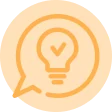
PRO TIP
Incorporate a touch of colour in headers or section breaks, but keep it professional and ensure it doesn’t detract from readability, especially in more conservative industries.
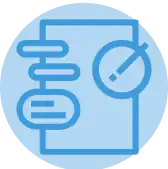
The top sections on a software tester CV
- Professional Summary highlights your testing ethos.
- Technical Skills exhibit specific testing tools expertise.
- Testing Certifications show commitment to professional growth.
- Work Experience details relevant roles and accomplishments.
- Education Background establishes foundational knowledge base.
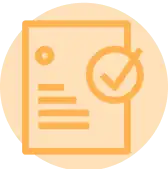
What recruiters value on your CV:
- Highlight your proficiency with various testing tools and technologies that are specific to software testing, such as Selenium, JIRA, or TestRail, to show that you are well-equipped to handle the technical aspects of the role.
- Emphasise your understanding of different testing methodologies like Agile, Waterfall, or TDD (Test-Driven Development), demonstrating your ability to adapt to various development processes and environments.
- Include any relevant certifications such as ISTQB, CSTE, or any other professional qualifications that are recognised in the field of software testing to establish your credibility and expertise.
- Detail your experience with bug tracking and reporting by mentioning specific instances where your efforts have led to significant improvements in software quality, as this showcases your impact on the product lifecycle.
- Showcase your analytical skills by providing examples of complex problems you’ve solved or how you have effectively planned test cases to cover various scenarios, indicating your critical thinking capabilities.
Recommended reads:
How to present your contact details and job keywords in your software tester CV header
Located at the top of your software tester CV, the header presents recruiters with your key personal information, headline, and professional photo. When creating your CV header, include your:
- Contact details - avoid listing your work email or telephone number and, also, email addresses that sound unprofessional (e.g. koolKittyCat$3@gmail.com is definitely a big no);
- Headline - it should be relevant, concise, and specific to the role you're applying for, integrating keywords and action verbs;
- Photo - instead of including a photograph from your family reunion, select one that shows you in a more professional light. It's also good to note that in some countries (e.g. the UK and US), it's best to avoid photos on your CV as they may serve as bias.
What do other industry professionals include in their CV header? Make sure to check out the next bit of your guide to see real-life examples:

Examples of good CV headlines for software tester:
- QA Analyst | Automation Expertise | ISEB Certified | Agile Methodologies | 3+ Years' Experience
- Senior Test Engineer | Functional & Non-Functional Testing | Risk Management | Certified Tester | 8 Years' Experience
- Junior Software Tester | Manual Testing Enthusiast | ISTQB Foundation | UI/UX Focus | 1 Year In Industry
- Lead Test Consultant | Strategy & Planning | Test Automation Frameworks | Selenium Proficient | 10+ Years’ Expertise
- Test Manager | Quality Assurance Leadership | Continuous Integration | Certified Scrum Master | 12 Years’ Experience
- Software QA Specialist | Performance Testing | Test Script Design | ISTQB Advanced Level | 5 Years' Practice
Catching recruiters' attention with your software tester CV summary or objective
Located closer to the top of your CV, both the summary and objective are no more than five sentences long and serve as an introduction to your experience. What is more, you could use either to entice recruiters to read on. Select the:
- Summary, if you happen to have plenty of relevant experience. Feature your most impressive accomplishments and up to three skills that are relevant to the job you're applying for;
- Objective, if you're just starting your career off. Provide your career goals and answer how you see the role you are applying for will match your professional growth.
Judging which one you need to add to your software tester CV may at times seem difficult. That’s why you need to check out how professionals, with similar to your experience, have written their summary or objective, in the examples below:

CV summaries for a software tester job:
- With over 7 years of dedicated experience in software testing at a leading tech firm in Silicon Valley, I possess a robust skill set including automated testing, performance testing, and agile methodologies. Proudly spearheaded the successful rollout of a large-scale software update resulting in a 20% increase in user satisfaction.
- As a seasoned Quality Assurance Analyst with 5 years of expertise in a fast-paced e-commerce environment, I bring to the table an exceptional knack for identifying critical bugs and a proven track record in improving product release quality by upwards of 30%, having mastered Selenium and JIRA.
- Translating 10 years of experience in database management into the field of software testing, I am eager to apply my rigorous analytical skills and attention to detail to ensure the highest quality software products while continuously learning about cutting-edge testing methodologies and tools.
- Embarking on a career transition from network security to software testing, my 8 years of technical experience has equipped me with a unique perspective on system robustness and user data protection that I am keen to leverage alongside learning industry-standard testing frameworks and software lifecycle best practices.
- Aspiring to launch a career in software testing, I am enthusiastic about applying a fresh perspective and rigorous work ethic to learn and excel in test case development, automation frameworks, and defect resolution to contribute to improving the quality of software applications and user experiences.
- With no previous software testing experience but a recent degree in Computer Science, my objective is to integrate a strong foundation in programming, a keen eye for detail, and an ardent desire for continuous learning to develop as an effective software tester while making meaningful contributions to product quality improvements.
More detailed look into your work history: best advice on writing your software tester CV experience section
The CV experience is a space not just to merely list your past roles and responsibilities. It is the CV real estate within which you could detail your greatest accomplishments and skills, while matching the job requirements. Here's what to have in your experience section:
- Prove you have what the job wants with your unique skill set and past successes;
- Start each bullet with a strong, action verb, and continue with the outcome of your responsibility;
- Use any awards, nominations, and recognitions you've received as solid proof of your skill set and expertise;
- align your experience with the role responsibilities and duties.
For more help on how to write your CV experience section, check out the next section of our guide:

Best practices for your CV's work experience section
- Conducted comprehensive manual testing for a range of web and mobile applications, ensuring alignment with user story acceptance criteria and design specifications.
- Implemented automated testing frameworks using Selenium and Python, reducing test cycle time by 40% and enhancing the efficiency of regression testing.
- Collaborated closely with cross-functional teams in Agile environments, participating in daily stand-ups, sprint planning, and retrospectives to continuously improve processes and outcomes.
- Identified, reported, and tracked bugs through their lifecycle using JIRA, consistently meeting resolution deadlines and prioritising issues based on severity and user impact.
- Developed detailed test plans and cases based on technical and functional requirements, achieving 95% test coverage for critical features.
- Optimised test environments and data sets for accuracy in testing, applying SQL for database validation and ensuring reliable test results.
- Facilitated UAT sessions with stakeholders to validate the functionality, usability, and accessibility of new features, documenting feedback for development teams.
- Maintained documentation of test results, procedures, and data, creating comprehensive test reports that drove product quality decisions.
- Stayed abreast of the latest testing tools and methodologies, including performance testing with LoadRunner, to contribute to the continuous improvement of test strategies.
- Lead the implementation of automated testing strategies using Selenium and Cucumber, which increased test coverage by 40% while reducing manual effort.
- Orchestrated the transition of testing protocols to a continuous integration/continuous deployment (CI/CD) model with Jenkins, enhancing the team's deploy frequency by 200%.
- Pioneered a quality metrics dashboard using TestRail, aiding the team in tracking defects and test outcomes more efficiently, which slashed time to market by 20%.
- Developed test plans and test cases for a cloud-based CRM solution that improved bug detection rates by 30% before the solutions reached the production environment.
- Facilitated user acceptance testing workshops for key product features, leading to a reduction in post-launch issues by 25%.
- Authored an extensive documentation library for testing procedures which were adopted company-wide, improving cross-team knowledge sharing.
- Led a quality assurance team in the agile development environment for mobile applications, increasing release quality by 35%.
- Designed and executed performance testing strategies that identified critical bottlenecks, enhancing system performance by 50%.
- Coordinated cross-functional teams during end-to-end testing phases, ensuring complete coverage of business requirements.
- Spearheaded the creation of a standardized test case template and workflow, which reduced onboarding time for new testers by 50%.
- Drove a testing initiative that successfully mitigated 90% of high-risk security vulnerabilities before product launches.
- Implemented a bi-weekly testing sprint, integrating product testing more closely with development sprints, which resulted in a smoother release cycle.
- Streamlined defect management processes utilizing JIRA, improving communication between development and QA teams which increased fix rate of bugs by 60%.
- Executed comprehensive regression tests for quarterly software updates, ensuring a 99% success rate on features before they reached the staging environment.
- Collaborated with offshore teams to extend testing capabilities, which achieved a 24-hour testing operation and reduced lead time by 33%.
- Optimized existing test cases for enterprise-level ERP software, which resulted in a 25% reduction in average test cycle time.
- Conducted rigorous stress testing scenarios which uncovered key areas for scalability improvements, influencing the successful handling of 20% more simultaneous users.
- Played a pivotal role in the pre-launch risk assessment, identifying critical bugs that would have impacted 30% of the user base.
- Initiated a comprehensive test automation program using Python and PyTest, resulting in a reduction of repetitive manual tests by 80%.
- Expertly managed a suite of over 500 automated test scripts, ensuring high code quality and contributing to a reduction in the defect escape rate to less than 1%.
- Collaborated with software developers to integrate unit tests into early development phases, effectively reducing the number of issues at the QA phase by 40%.
- Executed and reported on system-level testing for major updates to existing applications, improving overall software stability by 30%.
- Established a peer review culture for test scenarios that enhanced the test accuracy and reduced overlooked defects by 45%.
- Played a key role in the post-release monitoring of applications, quickly identifying and documenting anomalies for prompt resolution.
- Collaborated with product development teams to design and implement rigorous security testing protocols for new software products, significantly reducing potential exploits.
- Championed a client-focused testing approach that aligned test scenarios with user stories, delivering a more intuitive user experience and a 20% increase in customer satisfaction ratings.
- Leveraged data-driven testing techniques to pinpoint areas of improvement, influencing a major overhaul of the user interface that led to a 15% drop in user-reported issues.
- Introduced a test-driven development framework that was crucial in a 5% decrease in production bugs, enhancing overall software reliability.
- Engaged in performance testing to optimize response times for high-traffic web applications, achieving an improved load time performance by 20%.
- Actively participated in sprint planning and retrospectives, providing QA insights that were integral in shaping the direction of product development cycles.
Swapping your professional experience (when you have none) with skills and more
Never underestimate the importance of relevancе when it comes to your software tester CV. Even if you don't happen to have much or any standard (full-time contract) professional experience, this doesn't mean you shouldn't apply for the role. Instead of a bespoke CV experience section:
- Showcase more prominently any internships, part-time roles, and volunteer experience that are applicable to the role and have taught you job-crucial skills;
- Feature a strengths or achievements section with your transferrable skills or talents you've obtained thanks to your work or life experience;
- Write an objective statement that clearly outlines your values as a candidate and defines your career ambitions;
- List your education or certificates that match the job profile closer to the top of your CV.
Recommended reads:

PRO TIP
Describe how each job helped you grow or learn something new, showing a continuous development path in your career.
Key software tester CV skills: what are hard skills and soft skills
Let's kick off with the basics. You know that you have to include key job requirements or skills across your CV. For starters, take individual skills from the job description and copy-paste them into your CV, when relevant. Doing so, you'll ensure you have the correct skill spelling and also pass the Applicant Tracker System (ATS) assessment. There are two types of skills you'll need to include on your CV:
- Hard skills - technical abilities that are best defined by your certificates, education, and experience. You could also use the dedicated skills section to list between ten and twelve technologies you're apt at using that match the job requirements.
- Soft skills - your personal traits and interpersonal communication skills that are a bit harder to quantify. Use various CV sections, e.g. summary, strengths, experience, to shine a spotlight on your workspace achievements, thanks to using particular soft skills.
Remember that your job-winning CV should balance both your hard and soft skills to prove your technical background, while spotlighting your personality.
Top skills for your software tester CV:
Manual testing
Automated testing
Test planning and documentation
Defect tracking
Regression testing
Performance/load testing
Functional testing
API testing
Cross-browser testing
Mobile application testing
Analytical thinking
Attention to detail
Problem-solving
Communication skills
Adaptability
Teamwork
Time management
Critical thinking
Continuous learning
Work ethic

PRO TIP
Order your skills based on the relevance to the role you're applying for, ensuring the most pertinent skills catch the employer's attention first.
CV education and certificates: your academic background as proof of your skill set
A common misconception about your software tester CV education is that you only need it, if you have less professional experience. That is completely false. The CV education section serves to back up your technical (and sometimes personal) capabilities, fill in gaps in your work history, and show you have the initial industry background and know-how. When creating your education section:
- List your degrees in the reverse chronological order, starting with the most recent (and relevant) ones first;
- Include your degree and university names, start and graduation dates. It's optional to also denote you received a "First-Class Honours" for diplomas that are more relevant to the role;
- Curate your relevant university coursework, projects, or thesis work if you happen to have less professional expertise and need to integrate more job keywords and skills.
Your professional qualifications don't need to stop at your academic background. It's advisable to also select up to three of your most noteworthy (and relevant) industry certificates and feature them in a dedicated section. Once more, include the certificate name, the institution that issued it out, and the date you obtained it on. You could feature both hard skills and soft skills certificates, as in the examples below:

PRO TIP
If you have received professional endorsements or recommendations for certain skills, especially on platforms like LinkedIn, mention these to add credibility.
Recommended reads:
Key takeaways
Your successful job application depends on how you well you have aligned your software tester CV to the job description and portrayed your best skills and traits. Make sure to:
- Select your CV format, so that it ensures your experience is easy to read and understand;
- Include your professional contact details and a link to your portfolio, so that recruiters can easily get in touch with you and preview your work;
- Write a CV summary if you happen to have more relevant professional experience. Meanwhile, use the objective to showcase your career dreams and ambitions;
- In your CV experience section bullets, back up your individual skills and responsibilities with tangible achievements;
- Have a healthy balance between hard and soft skills to answer the job requirements and hint at your unique professional value.
